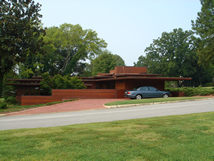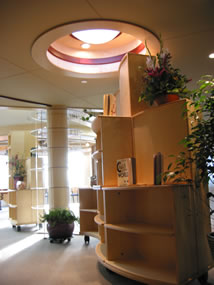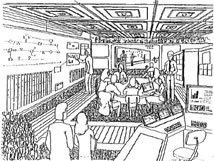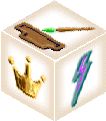The Next Generation
Taylor Environment and System
|
| The
7 Domains Model is an audit tool. We use it to understand
an existing circumstance and to build the program
intent of a new work. In 2005, MG Taylor began the process of developing a new generation
of NavCenters and deployable RDS units. These will
have global reach as they are likely to be the
first generation of our Centers that will be networked as we have always intended and therefore
capable of taking on large-scale systemic work that
goes beyond the capability of any single organization or
government. |
| This
means that we will be able, for the first time, to do the work - on the scale necessary for success
- that we conceived of in 1975. This next generation of NavCenters will have mission [link: MG Taylor Mission Statement] capability. If 30 years seems like
a long cycle it should be pointed out that, despite
the proliferation of innovation and the feeling that
it is coming from everywhere all at once, that true innovation curve
is still generally a two generation cycle - the first
generation for the idea to be created,
developed, demonstrated and discovered; the second generation
for it to be broadly accepted and disseminated across
our globe. This kind of time lag is not longer acceptable given the challenges that, as a a society, we face. The great constraint of innovation, today, is not ideas, technology, money or recognized need. The constraint is the connections between widely disbursed resources are not nearly as fulsome and “intelligent” as what is needed. This is why a global network of NavCenters is an essential tool for the systematic elimination of large-scale systemic problems. With truly complex problems, local resources are rarely enough and the stakeholders are usually widely distributed significantly beyond the the boundaries of a single locality. Any specific action is usually local but context and consequence is usually of far greater scope in terms of place and time. |
 |
| This
picture was taken August 6, 2005. The house
was built in 1939 and expanded in 1948. The
car is a current model of
a Jaguar which was first built in the mid 50s.
I think they go very well together and neither
looks out of date. |
|
| The
house is an USONIAN [link] built
by Frank Lloyd Wright for Stanley and Mildred Rosenbaum [link] -
the first Usonian, the Jacobs
House [link],
was built in 1936. Go to my article [link] for
my analysis of the Rosenbaum House What Makes
an Usonian a Usonian and to The Usonian
Workplace [link] for
how these principles apply to the contemporary work
environment. Completing the innovation cycle does not mean copying the Usonian house; it means understanding Usonian principles and applying them to contemporary housing and the realm of the workplace. |
 |
| The
Master’s NavCenter, built in 2004,
applies Usonian principles to the workplace.
The
AI WorkFurniture grammar is a direct descendent
of the way that Usonians were
both built and furnished.
The two generation cycle from
innovation to ubiquity can be seen in this
example. The Usonian Workplace [link] explores the link between the Usonian houses
and MG
Taylor NavCenters. |
|
| The
Usonian house was a way of building based on a way of living. It established a simple architectural grammar that could be applied in an always unique way to a wide number of different family requirements and physical sites. It was not prefabrication in the physical sense. It established a conceptual pattern language and modularity that enormously simplified the design/build process while facilitating a series of individual works of art. The Usonian House was a process as much as it was a physical solution. It was an early example of how diversity can emerge out of standard methods. |
 |
| MG
Taylor’s 1982 THERE vision [link] of collaborative
knowledge augmentation. Many of the technology components shown here now exist - the way of working depicted is still rare. |
|
| The
use of technology augmentation illustrated above has roots back in the late 1940s. I started development of applying augmentation to architecture in the early 60s and to work processes in the late 70s. We have been building environments that integrate collaborative work processes, technical augmentation and organic environments for 25 years. Projects that I would consider to be a full expression of these ideas are now on the drawing boards and will be built over the next few years. With these in operation, it will be possible to then realize these capabilities at the scale [link: the xanadu network] we envisioned in 1979 [link: 1979 - birth of an idea]. |
| This
short digression with these examples of the innovation
cycle are relevant to both the 7 Domains Model
- and its appropriate use - and specifically to this AUDIT of
the next generation of the Taylor System and Method.
The basic method of the audit process is based on
the Taylor Axiom You cannot get THERE from HERE
but you can get HERE from THERE. The vision
cannot be pushed into the future - it must be recreated
[link].
In practical terms, this has to be done over time
in a series of incremental steps. Each of these have
to address contemporary requirements while bringing
a significant piece of the vision to the HERE of
the present project and opportunity. |
|
| The 7 Domains Model identifies the domains that must be managed so that organizations and people do not have to be managed. At its root is a radical revolution in traditional management theory. The DesignShop® process and the NavCenter® environment and system are the living labs and their results are proof of concept of this supposition. |
| People are complex self-managing systems. They “have to” be managed only when other factors - necessary for self regulation - have been distorted, weakened or eliminated. Human organizations do not come with the self-managing attributes that a human being does. This leads to the logical, yet erroneous, assumption that they have to be managed. Instead, the attributes of an autonomous system have to be installed in an organization that creates the equivalent mechanisms necessary for self-management and makes them operable throughout the system of the organization. In this way, organizations can be regulated and emergent; orderly and spontaneous; stable and regenerative. |
| Each of these Domains are made up of several processes. These processes have to be conducted. They facilitate human action. The sum of this human action is the output of the system. The system of the organization is regulated in two ways. The feedback from outside the organization which is the consequence of the output. The feedback within the organization which is the consequence of the actions taken that produce the output. If the system of the organization is designed well and in balance, the organization will be self-regulating. The people will work in an environment that facilitates collaboration and creativity. |
| Below is a brief description of each of the 7 Domains. Following this, is the vision of each as it applies to the next generation of the Taylor environment and system. |
 |
BODY of KNOWLEDGE:
The Body of Knowledge of an organization, its most valuable asset, is rarely managed. The human body-mind is an integrated system. It has memory. No experience is lost to it although there are a number of factors that can influence our ability to “recall” what we know and is is technically possible for the brain to actually forget specific things. Each human learns to use this system in different ways and there is a wide bandwidth of skill in how well different individuals employ their mental facilities. Nevertheless, nearly all humans have a remarkable competency which comes with life itself and that we do not question.
This natural gift makes us almost universally blind to the central knowledge challenge of any organization: the fact that the organization does not come with the wiring and programming anywhere near equivalent to a single person. This means that several key competencies of life are lost to the organization. This results in the futile attempt to make traditionally structured organizations perform in ways that they are simply not designed to function. Therefore, these organizations cannot act as integrated systems. They lack an effective OS. they cannot - as a whole organization re-member. GroupGenius® is impaired. Its so called Body of Knowledge is distorted and fragmented.
This problem exists on multiple levels of recursion, reoccuring over and over: team, group, organization, corporation, political unit, nation, region and all of humanity. The amount of overhead spent trying to overcome this deficiency is staggering. |
|
 |
PROCESS DESIGN and FACILITATION:
The mo |
|
 |
EDUCATION and TRAINING:
The mo |
|
 |
PHYSICAL ENVIRONMENT:
The mo |
|
 |
|
 |
PROJECT MANAGEMENT:
The mo |
|
 |
VENTURE MANAGEMENT:
The mo |
|
| The most significant aspect of the model is not the domains themselves although they do have to be understood, developed and managed well. It is the connections between the Domains that is critical to get right. It is how the system as a system works - how it operates - that determines the true quality of the total environment in which people work. |
| Often, when people first look at this Model they say “where are the people?” “How can you have a model of organization without people?” They think the Model lacks a human sensitivity and is too mechanical. My answer is that the people work in the total environment (physical environment, work processes and tools) built according to this model. People do not need to - in fact, cannot - be managed. Create the right environment and people can act naturally which means their creativity and ability to collaborate emerges organically. Management is necessary. In the knowledge work/design economy, management becomes self managed individuals, teams and systems. These will aggregate into a self managed organization if - and only if - these organizations are “wired” with rule-based algorithms that can make it so: a functioning OS. The METHOD to do so is what the Taylor system is. DesignShops demonstrate that this is possible. |
|
VISION - Next Gerneration |
Matt Taylor
Nashville
August 7, 2005

SolutionBox voice of this document:
INSIGHT • POLICY • PROGRAM
|
posted: August 7, 2005
revised: October 1, 2005
• 20050807.299791.mt • 20050827.092355.mt •
• 20050913.409811.mt • 20050914.001234.mt •
• 20050927.888800.mt •
20051001.391893.mt •
(note: this document is about 20% finished)
Matt Taylor 615 525 7053
me@matttaylor.com
Copyright© Matt Taylor 2005 |
|
|